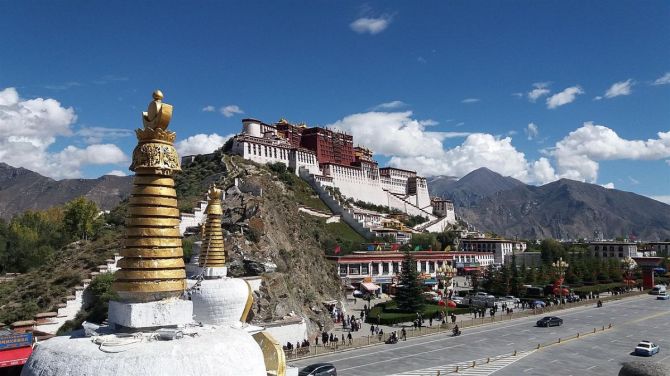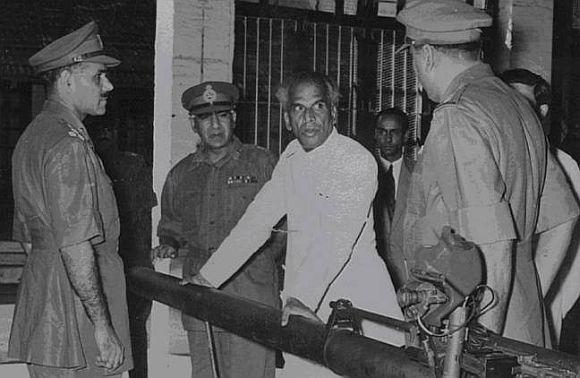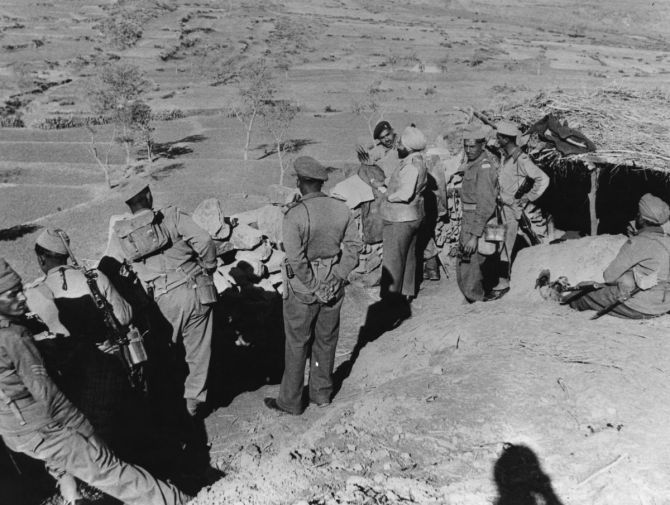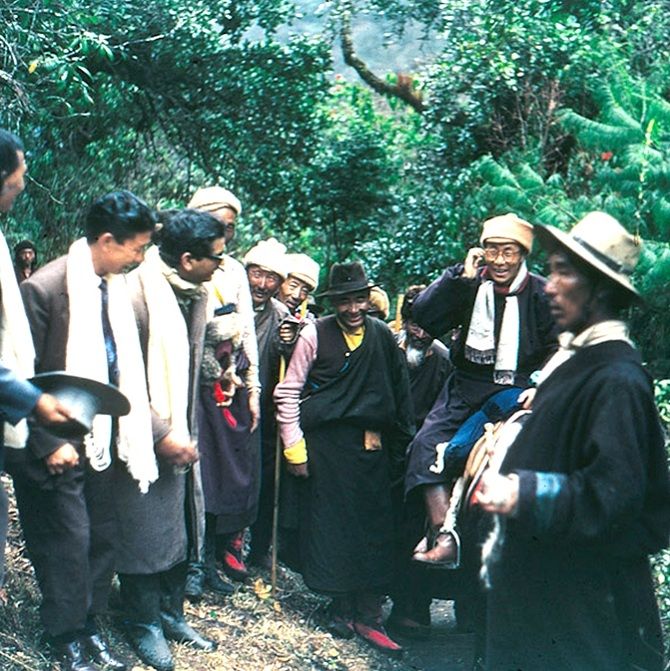Claude Arpi deserves to be complimented for the commitment and hard work that have gone into this production.
The frustrations of seeking reliable documentation from the catacombs of the Indian bureaucracy did not deter him from going after the best information available, and the result is one that he can take much satisfaction in.
Ambassador Prabhat P Shukla, Member Advisory Council, Vivekananda International Foundation, reviews Claude Arpi's The End of an Era: India Exits Tibet.

This is the fourth and final volume in Claude Arpi's tetralogy on India-Tibet relations from 1947 to 1962.
Its dolorous title, The End of an Era - India Exits Tibet sums up the author's sorrow and anger at the way things ended up.
It is, at the same time, one for the ages; the extensive coverage of first-hand sources makes it not just an intellectual tour de force, but also a valuable reference work.
The final volume covers the period 1958 to 1962, and tells the story of how the situation in Tibet reached a stage where open rebellion broke out against Chinese rule, the growing differences and distance between the Indian and Chinese leaders, and the war of October-November 1962.
Arpi also explores the internal balance of power in China, and clearly links the hardening of Chinese positions on the border, and on India, to the return of Mao to active power after having been side-lined as a result of the failure of the Great Leap Forward.
In the course of his researches, Arpi unravels very important facts.
For one thing, he shows that the construction of the Lhasa-Urumqi Highway was known as early as 1953, and confirmed by an Army reconnaissance team in 1957.
The report was submitted to the political leadership, but was rubbished by Krishna Menon as American propaganda.
Another insight provided is that Indian Air Force reconnaissance flights had established, as late as 1961, that the Chinese had no air assets worth the name in Tibet.
This being known to the political and military leaders, it remains a puzzle why Nehru did not use the IAF in 1962.
It might have made the difference between humiliation and honours even.
Enough has been written about the intelligence failures, but this was not one.
This was more a loss of nerve.
Because Nehru did ask the US for twelve squadrons -- no less! -- of fighter aircraft and pilots in the perfervid weeks of the war.

Arpi also narrates the account of the meeting between Krishna Menon and Chinese Foreign Minister Marshal Chen Yi in the summer of 1962, as war clouds were gathering.
But Chen assured the Indian leader that there would be no war.
At the same time, the author notes that there is no record of the discussion that took place.
That begs the question whether this is indeed an accurate and full account of the talks.
It also highlights, as Arpi does, the importance of watching internal developments in the adversary: the increasing role of Mao and his defence minister Lin Biao, who was moved into that position shortly after the Tibetan Uprising of March 1959.
Even if Chen did indeed give such an assurance, and even if he was sincere, both big ifs, there was the problem that he was not in a position to deliver on that assurance.

The chapters on the Tibetan Uprising provide a wealth of detail, both as seen by the Indian consul-general and, in a separate chapter, as seen from China.
That rouble was brewing was apparent because the Chinese advised Nehru not to visit Tibet, though he had been invited by both the Dalai Lama and the Panchen Lama.
The precipitating factor was, beyond doubt, the oppressive Chinese rule, in violation of the 1951 Agreement.
The idea was for the formation of an independent Tibet under an all-of-society Commission.
The crackdown that followed reverberated around the world, especially after the Dalai Lama escaped to India at the end of the month.
Arpi also adds the view from China: this is the booklet called The 1959 Tibet Uprising Documents - Chinese Army Documents.
Released a 'few years ago' according to the author, they show that the PLA took a realistic view of the situation inside Tibet on the Chinese side as well.
The documents acknowledge that 'the Chinese were not popular in Tibet' and complained about 'the influence of foreign secret service agents' inside Tibet.
The documents also admit that by the spring of 1959, the army had lost control of the situation on southern Tibet.
Weapons were coming in from Nepal, which also, along with India, had a consulate-general in Lhasa.
Particularly noteworthy, it seems Mao was initially inclined to let the Dalai Lama escape to India, and gave relevant instructions on 12 March 1959.
He subsequently changed his mind, around 17 March, and ordered that he should be stopped.
There is some evidence for this in Jianglin Li's book, Tibet in Agony, Lhasa 1959, but it does not square with Arpi's own assessment that Mao was weakened after the failure of the Great Leap Forward.
And yet, it is worth bearing in mind, for what it tells us about the nature of Chinese decision-making.
It is not all-seeing and allwise, as much of the hagiography on China would suggest.

The parts of the book dealing with the border talks reflect Arpi's pain and confusion at the same time.
He is clear from the outset that this volume does not cover the India-China boundary negotiations.
And yet, they do logically figure in the narrative.
Arpi is convinced that the Chinese were serious about the offer of a swap -- India accepting their alignment in Aksai Chin, and they accepting India's alignment in the east, the McMahon Line.
There is palpable anger and disappointment in him over the lost chances.
An intriguing part of the book is the fate of the 1961 UN General Assembly Resolution on Tibet.
This is because this was the first, and most important international document on Tibet since the Chinese occupation.
However, Arpi leaves the chronology hanging, which is so unlike him.
The Resolution is the first UN document that calls for self-determination for Tibetans; India did not support the Resolution, and indeed, India spoke to the issue only in 1965, after Nehru was gone.
However, this is an important document and remains on the record of the UN.
Those who argue that General Assembly Resolutions are not binding need to remember that Israel was created by a vote of the General Assembly.
Arpi does not see this chronicle to its conclusion.
A minor fault, in a magisterial study spanning four volumes.
Arpi deserves to be complimented for the commitment and hard work that have gone into this production.
The frustrations of seeking reliable documentation from the catacombs of the Indian bureaucracy did not deter him from going after the best information available, and the result is one that he can take much satisfaction in.
Thanks also to the United Services Institution of India for supporting Arpi's work.

Of course, it would be a pity if the books were only to be read and put aside as one more contribution to the literature on the subject.
For there are topical issues here, as we pass "peak China", in the sense that it is growing increasingly isolated diplomatically, and several of these questions become live again.
Most striking for me is the obvious regret that Arpi has for the missed opportunities offered by the Chinese for a swap.
If they were serious - there would be difficulties in the details - we should be clear that a settlement implies equally a closure of the Tibet question.
It is instructive to read the Simla Convention documents and the near-parallel agreement between the Russians and the Mongolians.
Starting from almost exactly equal positions vis-a-vis the Chinese, today, Mongolia is a sovereign country, Tibet is under the jackboot.
The Russians, and the Soviets after them, were unrelenting in their demand for recognition of Mongolian independence, from Republican, Nationalist and Communist China.
India clearly was not. And there is an oddity here: in April 1947, when Nehru organised the Asian Relations Conference, he treated Tibet as an independent country.
Its flag was displayed among all other nations' flags, its representatives travelled on Tibetan documents.
Despite protests from the Nationalist China delegation, Nehru maintained this position and in his welcome address, he counted Tibet among the countries represented.
But, inexplicably, he recognised Communist China's sovereignty over Tibet.
No satisfactory explanation has been found for this volte-face.
The answer may possibly be in the archives "lost" or in the British archives which are unavailable, for they were in close consultation with Nehru on these issues.

This was the original sin in our northern policy.
Some Indian leaders saw all this clearly, notably Sardar Patel and Sir GS Bajpai, and advised Nehru to exercise caution.
But that was not to be.
Even among outsiders, the dangers were well understood.
An article in Foreign Affairs [India and the Tibetan Tragedy by C H Alexandrowicz, April 1953] (external link), shows unusual prescience and points out that, through its hold over Tibet, China would extend her claims over territories that were once under Tibetan control - Sikkim, Darjeeling, Bhutan, and Nepal, the last of which used to pay quinquennial tribute to the Chinese Emperor until 1908.
And, of course, the Government of Tibet had raised these claims against India in October 1947.
The Chinese appear to be following the very pattern of behaviour described by Alexandrowicz.
His warnings, too, were written before the Panch Sheel Agreement of 1954.

It is frequently argued that India did not have a military option in 1950, when the Chinese invaded Tibet.
In the light of the information provided by Arpi and others, this is open to serious doubt.
It is worth emphasising that the Chinese were obliged to move their goods to Tibet through India at that time.
Direct communications were so poor that even the commanding officer of the Chinese forces in Tibet, General Chang Ching-wu travelled through Calcutta to Kalimpong and thence on to Yatung where he met the Dalai Lama.
In fact, after the 1954 Agreement between India and China on border trade, China signed another agreement with India the same year for trade through Calcutta with India and for transit to Tibet!
It is also worth remembering that China was embroiled in the Korean War at the same time, and its resources, limited as they were, were also fully stretched.
And it has already been established in the book that China had no worthwhile air assets at the time.
So, India was in a good position to exercise military pressure, if Nehru had chosen to do so.
More important, even if Nehru decided to give up the military option, that was no reason to abandon diplomatic efforts to address the situation.
Even that was given up.
Just as the UN Security Council was sitting to discuss the question of Tibet, India informed the body that bilateral talks between Tibet and China were due to start, and a solution would be found within that framework.
So the man who took Jammu and Kashmir to the UN Security Council prevented Tibet from being placed before that body.
No wonder John Kenneth Galbraith, in his memoirs as Ambassador in India observes, 'Indians are the world's safest objects of animosity'.
Feature Presentation: Aslam Hunani/Rediff.com









